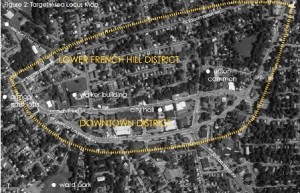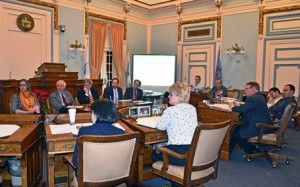By Michelle Murdock, Contributing Writer

Photo/submitted
Marlborough – Based on recommendations from the Urban Land Institute's (ULI) Technical Assistance Panel (TAP) Report, the Marlborough Economic Development Corporation (MEDC) announced Feb. 4 that it plans to bring forward substantial zoning changes in the city designed to stimulate economic growth in the downtown area.
Prior to the official announcement by MEDC, the final TAP Report, which included recommendations related to zoning and land use, parking, development financing, development incentives and physical planning/design recommendations, was presented to the City Council's Urban Affairs Committee in a meeting held at City Hall.
Convened at the request of the MEDC, the ULI TAP members visited the city on Sept. 18, 2013, to explore the downtown area and gather input from local officials, business owners and area residents.? Comprised of a group of diverse professionals specifically assembled with expertise in the issues posed, the goal was to identify specific planning and development issues, and to make recommendations.
“There is no doubt that Marlborough is a thriving suburban community,” said MEDC Executive Director Tim Cummings. “We just needed to get an expert opinion and some concrete suggestions on how to go about developing the city to its full potential. The TAP report is full of very viable and actionable recommendations, so I am eager to kick off the implementation process and involved the public in the next steps.”
During the TAP process four essential questions were considered:
- ?Is there adequate parking to increase and attract new development?
- ?What incentives and/or financing will help make development projects in the two districts (downtown and lower French Hill District) more feasible?
- Are there current land use regulations in place that will hinder or encourage commercial growth?
- What are the appropriate land uses in the two target districts?
The next step involved coming up with a vision plan that would transform the area from a Main Street strip commercial corridor to a veritable Downtown District, encouraging new development and businesses to create a vibrant retail, restaurant and arts destination, and improving connections and links to the existing citywide assets.
Key recommendations presented to the members of the Urban Affairs Committee included bringing the current zoning up to date by creating zoning overlay districts that would allow mixed use developments, relaxing the number of parking spaces needed for new developments and looking at the possibility of shared parking agreements, and enforcing current time limits for on-street parking.? New use recommendations included a hotel, gym/fitness center and entertainment.
Short term recommendations included improved signage designed to create gateways to the downtown area, making it more of a destination, and developing a branding/marketing plan designed to get more people downtown, as well as attracting residents from surrounding communities.
“What we'se got here has to be better than what is over there,” said TAP Co-Chair Dick Lampman of G. Greene Construction.
Also discussed were various physical improvements such as lighting, benches and landscaping along Main Street, Granger Boulevard and the Assabet River Rail Trail to create a vibrant, convenient and inviting downtown district for residents and visitors.
Three final recommendations centered on making use of creating financing to incentivize redevelopment initiatives, encouraging adaptive project to revive vacant historic downtown buildings such as the armory on Lincoln Street, and creating a local transportation network ease access to the downtown area for residents and employees living and working outside the downtown area.
While some of the recommendations made were questioned by members of the Urban Affairs Committee, such as removing the slip lane (right turn lane) connecting Main Street to Granger Boulevard, the TAP members said the intent of the TAP was to provide a “quick, broad brush look” and not to provide hard and fast recommendations.
“The idea is to start the thought process, to think about the overall vision first and build towards it,” said Cummings who added that his organization will aim to begin enacting changes as early as May.
“I am very happy to have MEDC working with the City Council to help us turn some of these recommendations into reality,” said? Ward 1 City Councilor Joseph Delano, Jr. ,who is also the Urban Affairs Subcommittee chair. “The first step is for the MEDC and MAPC (Metropolitan Area Planning Council) to work with us to begin crafting a city ordinance that the City Council is comfortable with to allow for some additional uses here in downtown.”
The full TAP report is available for viewing or download at http://marlboroughedc.com/wp-content/uploads/Marlborough-ULI-TAP-Report-MEDC.pdf

Photo/Michelle Murdock











